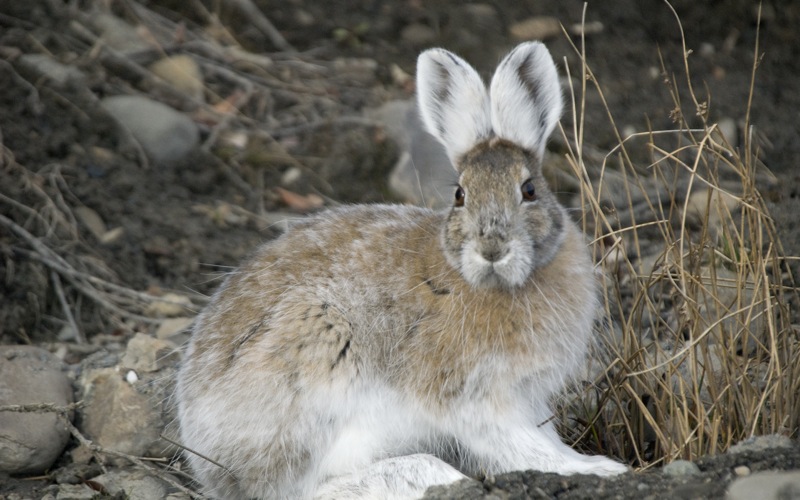
Out of the corner of my eye, I saw something large hop behind a bush. It dwarfed the ordinary cottontails that we see on our property.
Hopping again, I noticed something else.
The feet and ears were snow white, but the body remained an earthy brown. With its large feet and long legs, it hopped clear out of sight beyond the boundary of the campground.
The snowshoe hare was on the move.
Of all the things I expected to see in Alaska, snowshoe hare had not been on the list. Yet, we saw more of these furry creatures than any other wildlife while camping in Denali National Park.
Snowshoe hares aren’t just found in Alaska, although the habitat there is much more to their liking. But I’ve seen them in the sub-alpine forests of the Rocky Mountains here in Colorado as well, just not as plentiful. They do prefer woody forests in colder climates, where snow stays on the ground for long periods of time. That’s because as I spied on our visit, hares will change their coats from brown to completely white, allowing them to blend into the snow. The entire change will take about ten weeks, but if you’re lucky enough to spot them in fall, you’ll see an animal that looks mottled brown and white.
Every time I tried to take a photo, being nimble and quick, they would dart away. Good thing, as they are hunted by foxes, coyotes, and lynx.
Apparently, they’ve gone through a bit of population surge in during the past year or two.
“They seem to have populations surges every 10-12 years, I’m not sure why” the bus driver explained at one of our stops.
“However, it’s definitely brought about a lot of lynx sightings. I normally only see 1 or 2 lynx per season because they are so reclusive. But this year, I’ve seen ten.”
The snowshoe hare and Canada lynx have close-knit predator-prey relationship. The lynx prefers hunting and eating the hare more than anything else. When the hare population goes up, happy times are here again for the lynx.
While doing a program on wild cats at Rocky Mountain National Park, I tried to explain this to a bunch of 6 and 7-year old kids.
“What your favorite food?”
“Pizza!”
“Hamburgers!”
“Ice Cream!”
The responses were enthusiastic and varied.
“If you could only have one food to eat for the rest of your life, what would it be? You’d have to eat this food every day.”
They took a little more time to consider, but still offered up the same responses.
“Well, the snowshoe hare is like pizza for the lynx. It’s the one thing he wants to eat more than anything else. A mouse is like broccoli to him, he just doesn’t want it.”
The snowshoe hare has a problem. A 90-degree summer day in Alaska kind of problem. As temperatures warm, and winters are less cold, snow doesn’t stay on the ground as long. If the snowshoe hare turns white according to less sunlight, but the snow melts, he’s no longer camouflaged. His snow white body will make him stand out against the ground, and he will be somebody’s lunch.
Not only is this bad news for the hares, but bad news for the lynx. Unlike coyotes and foxes, he is unwilling to eat other things, and he may not survive.
So goes the hare, and so goes the lynx.

